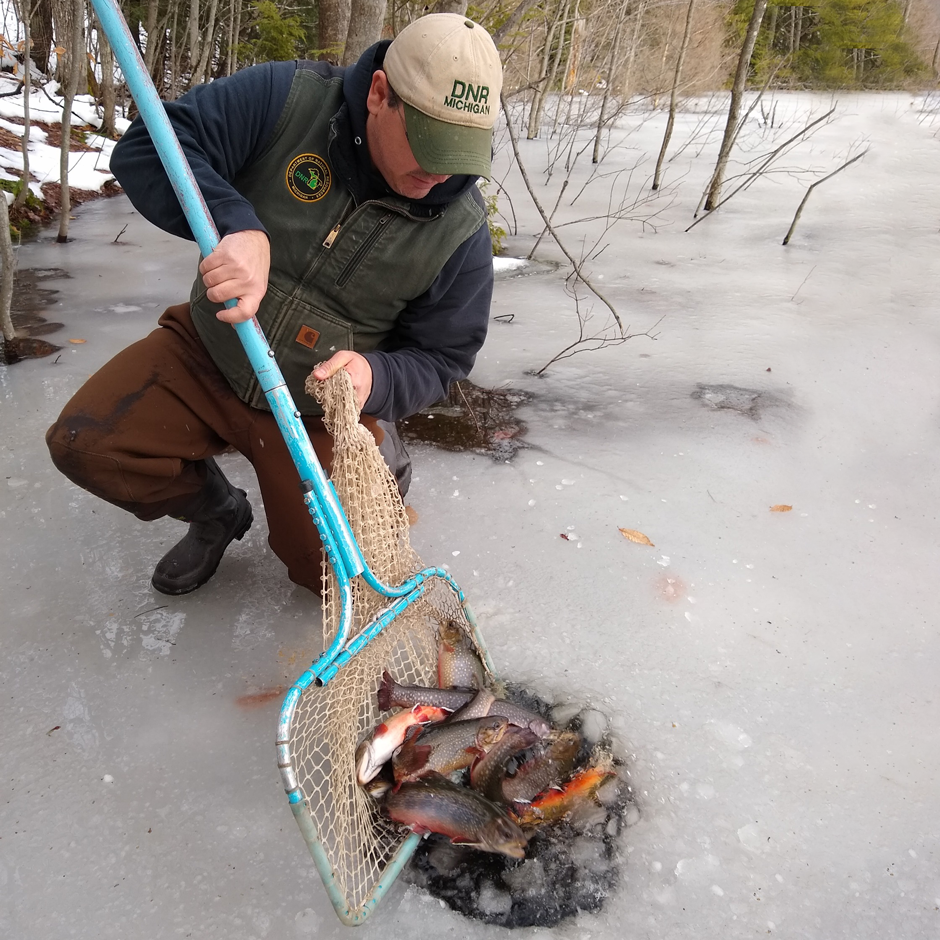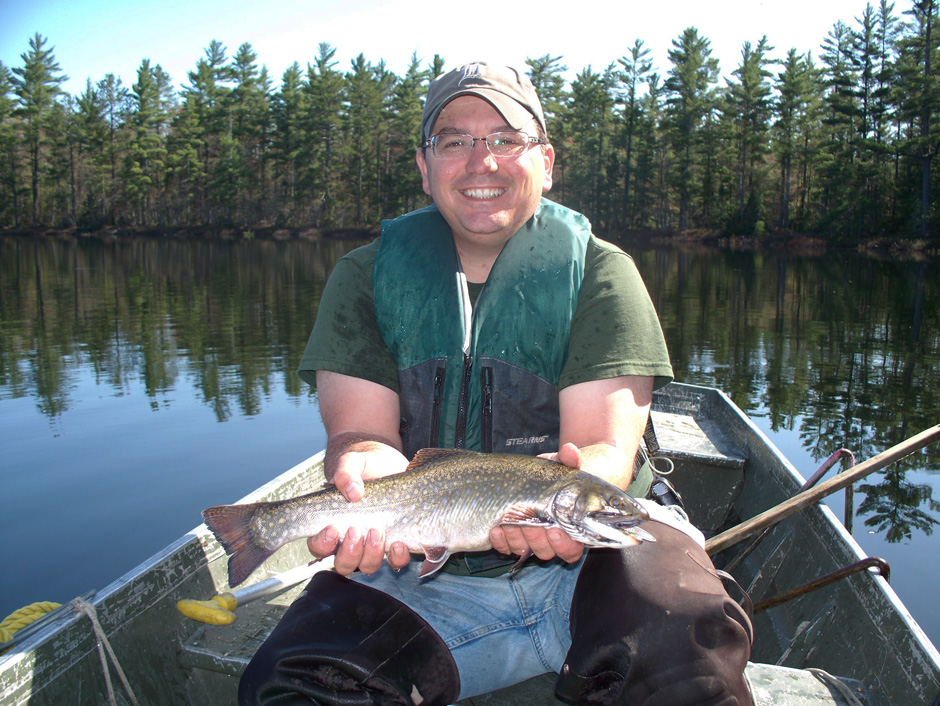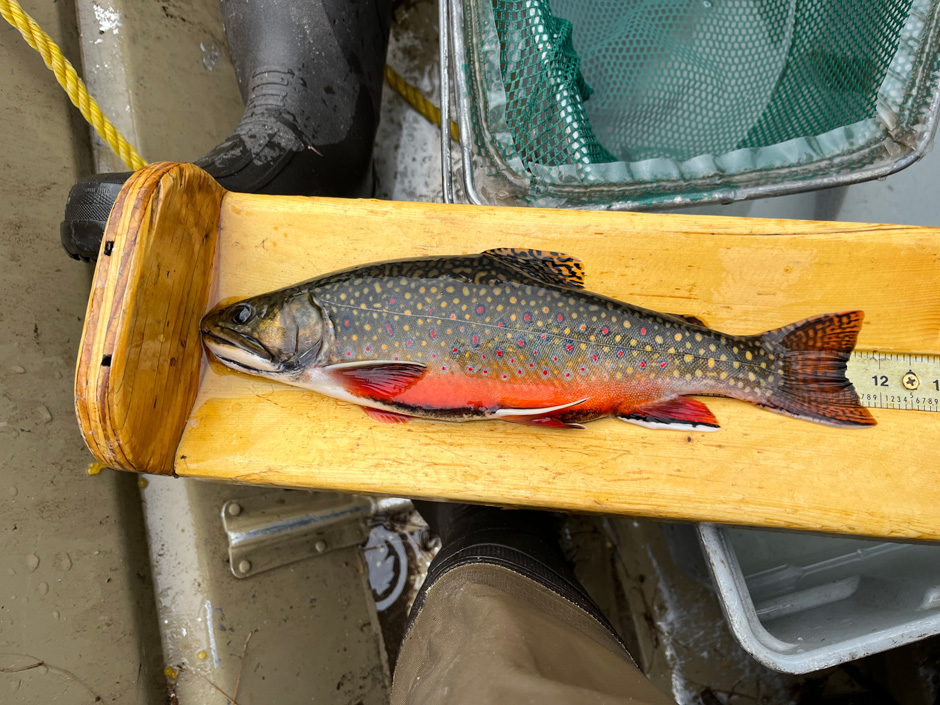Brook Trout Management in Michigan’s Upper Peninsula
 Michigan Department of Natural Resources stocking adult brook trout into an inland lake in Luce County. (Credit: MDNR)
Michigan Department of Natural Resources stocking adult brook trout into an inland lake in Luce County. (Credit: MDNR)Fishery management divisions across the U.S. are tasked with not only maintaining natural resources but also the happiness of residents and visitors who utilize the lakes and waterways they manage. In terms of balancing the two, Cory Kovacs, a Fisheries Biologist with the Michigan Department of Natural Resources (MDNR), and others like him have to make difficult decisions in order to combat various threats to the fisheries.
Threats to fisheries can come in many forms, such as invasive species, overfishing, water quality declines, and other environmental stressors. Kovacs is charged with responding to these changes and ensuring that local anglers can continue to enjoy native fish like brook trout—which, in turn, maintains a healthy ecosystem.
Unfortunately, despite the best efforts of managers, native populations may decline, and anglers who previously fished the waters may not return due to the limited availability of more desirable fish. In Luce County’s Dillingham Lake and Bullhead Lake, the emergence of yellow perch and, in later years, largemouth bass overwhelmed brook trout populations.
Brook Trout in Dillingham Lake
Dillingham Lake had been managed for over 40 years, stocking brook trout fingerlings and yearlings to keep the brook trout fishery active. However, a discovery of yellow perch led the MDNR to treat the water with a piscicide called rotenone in order to eradicate the yellow perch from Dillingham Lake. Unfortunately, due to the structural dynamics of Dillingham Lake, the treatment was considered to be unsuccessful.
“What happens is there are sometimes bog mats around the shoreline, where we can’t get the chemical to go or release underneath it—it’s very challenging. So because of the contours and some of the details of the shoreline and the vegetation and the bog mat types that we have around Dillingham Lake, we felt as though the treatment was ineffective,” states Kovacs.
Angler reports confirmed that the treatment hadn’t worked as anglers hoping to catch brook trout continued to catch yellow perch. Following the treatment, the MDNR restocked the lake with brook trout in 2015, which resulted in anglers reporting more brook trout catches, though yellow perch were also still reported.
In 2018, a change in the designation of the parcel enrolled in the Commercial Forest Program where the public accessed Dillingham Lake restricted the MDNR’s access to Dillingham Lake, so the lake was stocked for the last time that year. Public access was no longer allowed at this parcel due to a withdrawal from the Commercial Forest Program.
While the public can still access the lake through the woods on the west end of the lake through land enrolled in the Commercial Forest Program, fisheries trucks used for stocking aren’t able to reach the lake anymore. Due to the loss of management intervention, Dillingham Lake was removed as a Type A designated trout lake in 2020.

Brook trout like these can be found in Luce County-managed trout lakes. (Credit: MDNR)
Brook Trout in Bullhead Lake
Bullhead Lake is located in the Pretty Lake Complex and faced the same yellow perch boom that Dillingham Lake underwent. In 2014, the lake was treated with rotenone as well. Angler reports revealed that the treatment had successfully culled yellow perch in the lake, and so brook trout stocking immediately resumed. However, in 2019, angler reports started documenting largemouth bass in the lake—a species that occurs elsewhere in the Pretty Lakes Complex but historically not in Bullhead Lake.
While the exact origin of the species is unknown, Kovacs believes there are two likely causes. One, lakes in the area may have become connected at some point due to water levels rising, which allowed the bass to travel to Bullhead Lake. The other possibility, which Kovacs believes to be more likely, is that a bait bucket used in Bullhead Lake introduced the species.
While minnow use as bait is prohibited in Bullhead Lake, anglers often travel from lake to lake through portages, and it’s possible a largemouth bass was introduced this way. The incident has had a costly impact on brook trout in the lake and underlines the importance of outreach and angler education.
Kovacs explains, “Every opportunity I have, when I speak to anglers, I always ask them if they’re fishing in that complex to not move fish, because each one is managed uniquely for that experience.”
Due to the presence of largemouth bass, the MDNR decided to change its stocking approach. Instead of stocking yearlings and fingerlings, the MDNR chose to invest in retired broodstock brook trout. These are fish that were used at the Marquette State Fish Hatchery for spawning. The retired fish are fully grown and in the later stages of their life.
When the retired broodstock are available, only around 50 are stocked each year in Bullhead Lake. Anglers love the larger fish, and the strategy is effective at combatting the largemouth bass invasion. The expected mortality of the stocked adult fish is close to zero—comparatively, stocking the smaller fingerlings and yearlings faces higher mortality rates due to their size and susceptibility to predation by largemouth bass.

Brook trout captured during an MDNR fisheries survey on a Luce County Lake. (Credit: MDNR)
Considerations and Future Opportunities
While stocking the adult brook trout is popular with anglers and has been effective for the last several years, it’s a very costly investment. The adult broodstock cost almost $20 per fish compared to the yearlings, which cost around $5. Despite the higher cost, stocking the adults appears to be worth the investment as anglers return to the fishery each year and continue to sponsor management efforts through licensing and other expenditures.
Because all the brook trout in Bullhead are stocked, and there isn’t a natural spawning season to protect, the MDNR allows an extended fishing and possession season to the end of October. The changes to the season allow anglers to enjoy catching the limited stock later into the fall, which helps support a stronger relationship with the MDNR. All Type A and D designated trout lakes are open to fishing from the last Saturday in April to October 31.
Hope for the future of both lakes’ brook trout fishery is unfortunately shrouded in uncertainty.
“These lakes are living and I have other lakes that have been lost due to land acquisitions or land transactions or changes in designation, but they’ve also been lost because we don’t have the ability to really treat them anymore,” states Kovacs.
He continues, “There may be a day in the future where we walk away from Bullhead Lake [. . .] or we may gain better access to Dillingham Lake and we may want to maintain some kind of fishery there.”
While the goal is to continue stocking adult brook trout in Bullhead Lake and continue searching for a means to stock brook trout in Dillingham Lake once again, these situations are ever-evolving, and it’s important to adjust as conditions allow and regulations change.


Pingback: FishSens Magazine | Michigan revamping brook trout fisheries in two Upper Peninsula lakes - FishSens Magazine